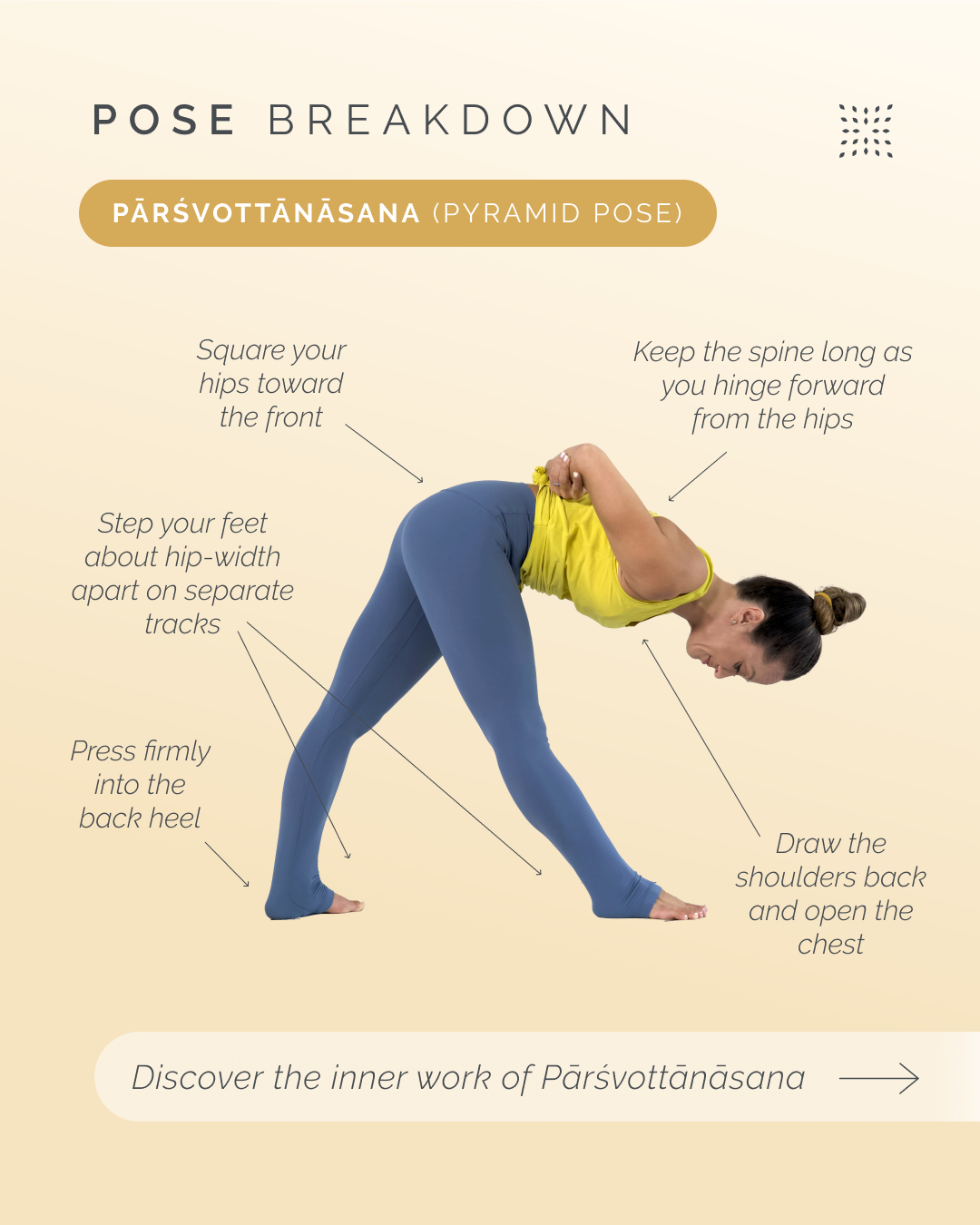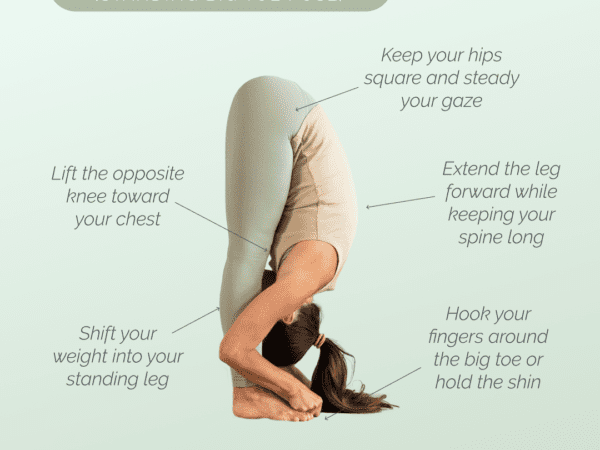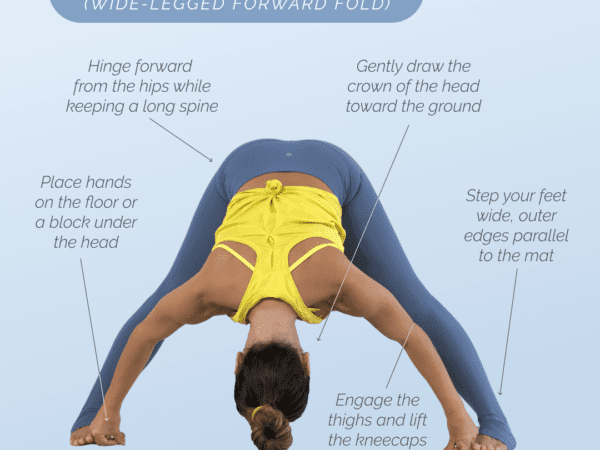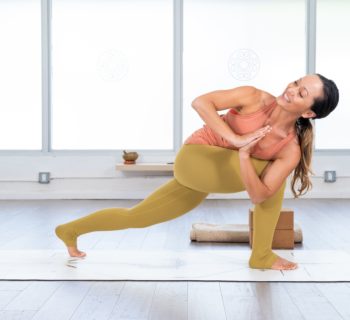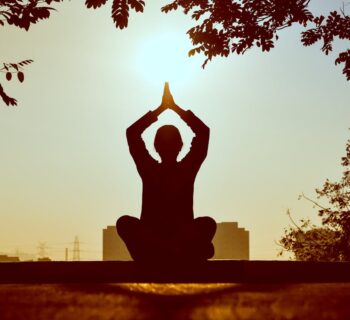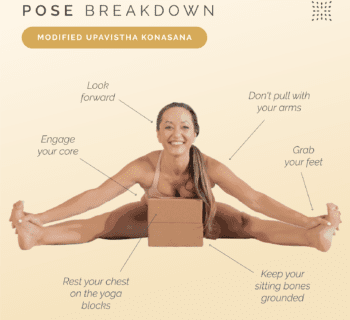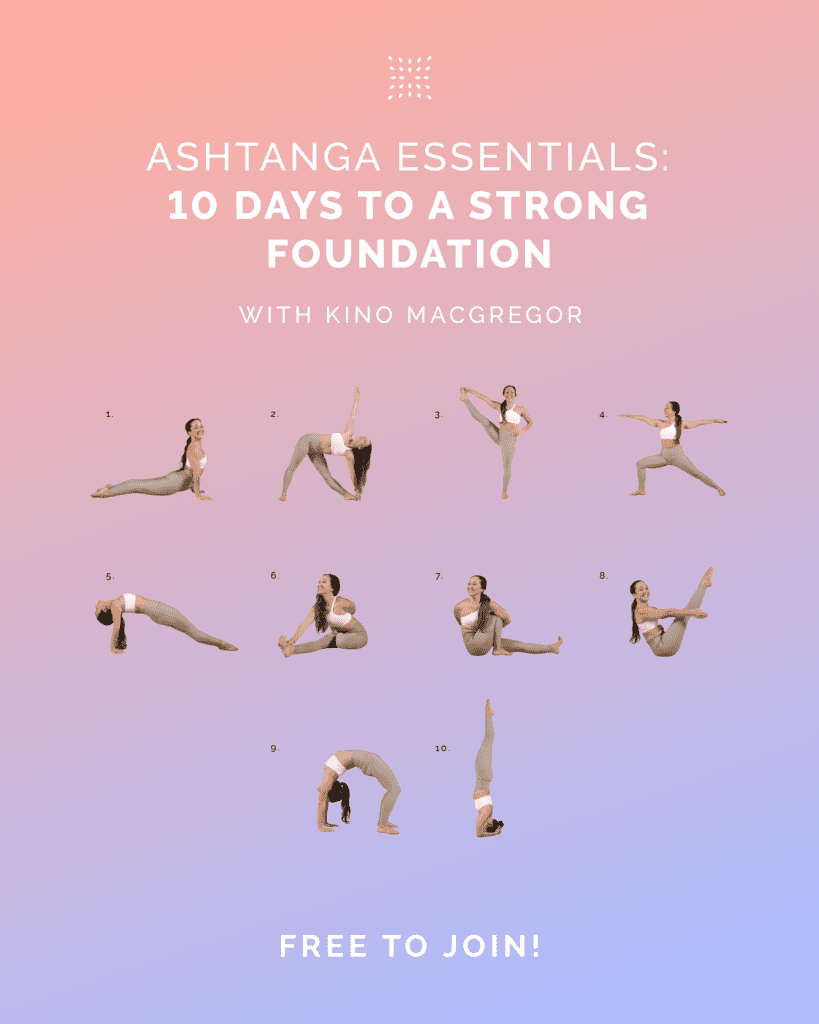The Sanskrit name Pārśvottānāsana unfolds its meaning with quiet symmetry. Pārśva means “side,” ut evokes intensity or upward direction, and tāna comes from the root meaning “to stretch” or “extend.” Although often translated as “intense side stretch,” the name holds a deeper resonance. When the body arranges itself into this asymmetrical forward fold, something happens that is more than anatomical. The posture becomes an architecture of devotion, a bridge between rootedness and ascension, between the density of earth and the subtlety of sky. In its triangular form, the body echoes an ancient geometry of stability and aspiration.
The Architecture of the Pose
At first glance, Pārśvottānāsana seems simple: one leg forward, one leg back, the torso folding toward the front leg. Yet within this apparent simplicity resides a subtle dialogue between grounding and release. The back heel anchors into the floor with unwavering steadiness. The front foot meets the earth with equal intelligence. Both legs engage not as isolated muscles but as a unified channel of upward and downward energy, drawing from the earth through the legs into the pelvic floor.
The pelvis seeks quiet alignment without sacrificing the integrity of the legs. Rooting through the balls of the feet, the bases of the big toes and little toes, and the center of the heels, the practitioner discovers the first truth of this posture: groundedness creates freedom. Many students hesitate to soften the back and descend, fearing that relaxation is a kind of collapse. Yet once the foundational work of the bandhas is established, relaxing the back with conscious elongation becomes essential. Only then does the forward fold reveal its depth.
The chest center aligns toward the front knee, encouraging a gentle internal rotation of the front hip, while the back hip rotates outward — at least forty-five degrees, sometimes as much as ninety — creating a stable base for the entire posture. The distance between the feet can be adapted. A shorter stance may allow access to the forward fold; a longer stance strengthens the back leg and intensifies the stretch. Alignment here is not rigidity but relationship — a conversation that evolves over time.
In the traditional Ashtanga approach, the posture is entered with the hands in prayer behind the back. The gesture is not about forcing the palms together; it begins with the internal rotation of the shoulders and the widening of the collarbones. For many bodies, holding the elbows or forearms offers greater integrity. Both options preserve the essential openness across the chest without stressing the shoulder joint.
There is also a flowing vinyasa variation in which the fingers interlace and the arms extend overhead before folding forward. In this version, the shoulders move in external rotation as the spine lengthens, creating a luminous arc of energy from the feet up through the fingertips.
Anatomically, Pārśvottānāsana strengthens the legs, stabilizes the sacrum, lengthens the hamstrings, broadens the upper back, and encourages axial extension of the spine. As the torso folds, the abdominal organs receive gentle compression, supporting digestion and calming the nervous system. The forward fold becomes as much an inward journey as it is an outward shape.
Pārśvottānāsana in Ashtanga Yoga
In the Ashtanga Yoga method, Pārśvottānāsana is the final posture of the standing sequence, marking a subtle transition from the grounding architecture of standing asanas into the fluid interiority of the seated sequence. All practitioners — beginners, intermediates, and advanced students alike — are advised to practice this posture daily.
Here, alignment becomes meditation. The careful organization of the hips, the rooting of the feet, the softening of the spine, and the opening of the chest reflect the core Ashtanga teaching that attention to detail is itself a practice of presence. When the outer body finds integrity, the inner body awakens. When the foundation is steady, the breath flows without obstruction. In this way, Pārśvottānāsana becomes a bridge between physical form and subtle awareness.
Iyengar Yoga
In Iyengar Yoga, Pārśvottānāsana becomes a study in precision. Heel-to-arch alignment is often emphasized, though heel-to-heel may also be used depending on the practitioner’s stability and structure. Props are not seen as shortcuts but as tools of revelation. A pair of blocks beneath the hands, a wall behind the back heel, or a chair to support the forward fold can illuminate the alignment of the spine and the organization of the pelvis.
Although Iyengar sequencing does not emphasize daily repetition of this pose as Ashtanga does, Pārśvottānāsana appears regularly in standing pose series. Its benefits — improved postural clarity, balanced hip rotation, hamstring lengthening, and increased awareness of the spine — make it a consistent companion in this method’s repertoire.
Contemporary Vinyasa and the Name “Pyramid Pose”
In many contemporary Vinyasa classes, Pārśvottānāsana is known simply as Pyramid Pose, named for the triangular architecture of the body: two legs forming the base, the spine rising like the edge of a sacred structure. Often placed between dynamic transitions, it becomes a pause in the current, a moment in which the breath gathers inward and the mind settles before the next unfolding.
The Symbolism of the Pyramid
The pyramid is one of humanity’s oldest sacred shapes — appearing in Egyptian temples, Mesoamerican pyramids, and the stepped sanctuaries of India. With its wide base rooted in earth and its apex rising to the heavens, the pyramid symbolizes stability, ascent, and the meeting point between the human and the divine.
Entering Pārśvottānāsana is like stepping into a temple whose entrance lies within your own body. The firm base of the legs creates steadiness, while the spine — long, extended, and descending toward the front leg — becomes the ascending line of aspiration. The forward fold invites the practitioner into the inner sanctum, the garbha-gṛha of the posture, where the mind quiets and the breath deepens.
In this way, the contemporary name contains an ancient truth: the pose is a sanctuary of grounding and upliftment, a structure of reverence built from one’s own body.
Contraindications
Pārśvottānāsana, like all forward folds, requires attentive listening. Students experiencing lower-back discomfort may benefit from shortening the stance, emphasizing stability over depth, or folding with hands supported on blocks or a chair. Those with hamstring sensitivity can soften the front knee and initiate the fold from the pelvis rather than pulling from the lower back. Individuals prone to dizziness may keep the head lifted. For students with wrist or shoulder discomfort, variations such as holding the elbows or forearms often provide the greatest comfort. The posture’s adaptability is part of its teaching: wisdom arises from honoring the body’s needs.
Chair and Supported Options
A chair can become a stabilizing ally in Pārśvottānāsana. Resting the hands on the back of a chair or placing the front leg on the seat allows the spine to lengthen without strain. A wall beneath the back heel can also offer grounding for those needing additional stability. These variations preserve the posture’s essential architecture while making its benefits accessible to practitioners of all levels, including beginners, older students, or those working therapeutically.
Reflection
To practice Pārśvottānāsana is to enter a quiet conversation between strength and surrender. The more deeply one roots, the more effortlessly one rises. The more one releases, the more strength becomes available. With time, the pose ceases to feel like an external form imposed from outside; it becomes an inner state — steady, humble, luminous.
The pyramid shape reveals its essence: a structure grounded in the earth and rising toward the unseen. A gesture of devotion expressed not through force, but through precision, breath, and grace. And in its forward fold, the heart remembers that bowing is not a sign of defeat but of reverence — a movement toward the stillness within.
To embody the pose, try this quick tutorial with Kino and Tim!


